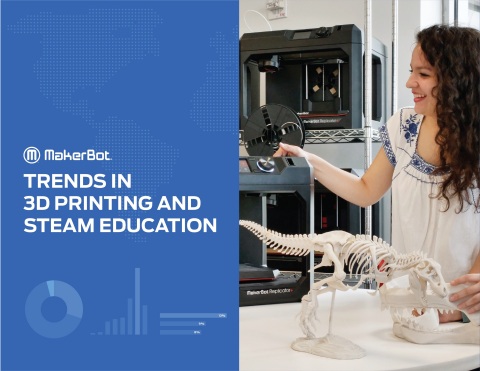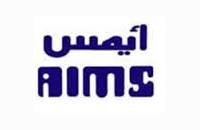MakerBot Releases New Report on Trends in 3D Printing and STEAM Education
MakerBot, a global leader in 3D printing and subsidiary of Stratasys Ltd. (Nasdaq: SSYS), today released its latest report, “Trends in 3D Printing and STEAM Education.” Based on over 1,000 responses from education professionals around the world, the report illustrates the use of 3D printing in education and how it is applied across grade levels among respondents.
This press release features multimedia. View the full release here: https://www.businesswire.com/news/home/20201015005817/en/

(Photo: Business Wire)
Key findings from the report reveal that 63% of respondents use 3D printing to better prepare their students for the workforce, but they want more than just a 3D printer in order to be successful—respondents want a full ecosystem of 3D printing resources in order to achieve their educational goals. 65% of respondents cited that online training programs would help them to implement the technology better, while 63% and 56% of respondents also cited lesson plans and educational webinars as useful 3D printing resources, respectively.
Nadav Goshen, CEO of MakerBot, noted, “We are at a pivotal moment in education. We have seen the use of 3D printing in education increase steadily over the past years due, in part, to the availability of more products and services geared toward teachers and students. Affordable and easy-to-use 3D printers, training and certification programs, integrated lesson plans, and online 3D printing resources have made the technology attractive to many educational institutions. In addition, working with 3D printers can help students develop practical and usable skills that can be used outside of the classroom.”
Additional key findings from the Trends in 3D Printing and STEAM Education report include:
- Authentic learning experiences are becoming a popular new teaching method. Design-based learning (57%), integrated learning (51%), and collaborative learning (49%) were identified as the top teaching methods among respondents. Only 42% of respondents stated that they still use traditional learning settings with students.
- Teaching STEAM subjects requires resources that schools may not have. Budget constraints (56%), insufficient equipment (45%), and lack of technical training (39%) were cited as the top challenges to teaching STEAM subjects.
- 3D printing is widely used to develop practical skills that can be used beyond the classroom. Respondents cited developing problem-solving skills (63%), skill sets for future careers (63%), and creative thinking skills (63%) as their top reasons for 3D printing adoption.
- Educators want more than just a 3D printer. They want a full 3D printing ecosystem. 82% of respondents cited 3D printing resources (i.e., lesson plans, training programs, etc.) as important factors when choosing a 3D printer.
- Costs, reliability, and ease-of-use play important roles in decision-making. 95% of respondents rated reliability as an important benefit, while 90% said ease-of-use was important and 89% said costs were important.
“The importance of 3D printing in education cannot be overstated. The report revealed the shift from traditional learning environments to more interactive and engaging approaches. By teaching visualization, design and creation via 3D printing, 3D printing opens up opportunities for students and brings ideas to life,” added Goshen.
About the study
MakerBot surveyed over 1,000 education professionals who are in its global network, from August 21-26, 2020. Respondents were based in North America (60%), Asia (15%), Europe (14%), South America (8%), Oceania (2%), and Africa (2%). They teach a range of disciplines, including 3D printing, art & design, mathematics, engineering, language studies, history, and more.
For the full report, visit https://pages.makerbot.com/edu3DPrintingTrendReport.html.
About MakerBot
MakerBot, a Stratasys company, is a global leader in the 3D printing industry. The company helps create the innovators of today and the businesses and learning institutions of the future. Founded in 2009 in Brooklyn, NY, MakerBot strives to redefine the standards for 3D printing for reliability, accessibility, precision, and ease-of-use. Through this dedication, MakerBot has one of the largest install bases in the industry and also runs Thingiverse, the largest 3D printing community in the world.
We believe there's an innovator in everyone, so we make the 3D printing tools that make your ideas matter. Discover innovation with MakerBot 3D printing.
To learn more about MakerBot, visit makerbot.com, the MakerBot blog, Twitter, LinkedIn, or Facebook. Stratasys (parent company of MakerBot) reserves the right to utilize any of the foregoing social media platforms, including the company's websites, to share material, non-public information pursuant to the SEC's Regulation FD. To the extent necessary and mandated by applicable law, Stratasys will also include such information in its public disclosure filings.
Note Regarding Forward-Looking Statement
The statements in this press release relating to Stratasys’ and/or MakerBot's beliefs regarding the benefits educators will experience from using MakerBot’s (or Stratasys’) products in educational settings are forward-looking statements reflecting management's current expectations and beliefs. These forward-looking statements are based on current information that is, by its nature, subject to rapid and even abrupt change. Due to risks and uncertainties associated with MakerBot’s (and Stratasys') business, actual results could differ materially from those projected or implied by these forward-looking statements. These risks and uncertainties include, but are not limited to: the degree of our success at introducing new or improved products and solutions that gain market share; the degree of growth of the 3D printing market generally and in the educational market, specifically; the duration of the global COVID-19 pandemic, which, if extensive, may continue to impact, in a material adverse manner, our operations, financial position and cash flows, and those of our customers and suppliers; the impact of potential shifts in the prices or margins of the products that we sell or services that we provide, including due to a shift towards lower-margin products or services; the impact of competition and new technologies; potential further charges against earnings that we could be required to take due to impairment of additional goodwill or other intangible assets; to the extent of our success at successfully consummating acquisitions or investments in new businesses, technologies, products or services; potential changes in our management and board of directors; global market, political and economic conditions, and in the countries in which we operate in particular (including risks related to the impact of coronavirus on our operations, supply chain, liquidity, cash flow and customer orders; costs and potential liability relating to litigation and regulatory proceedings; risks related to infringement of our intellectual property rights by others or infringement of others' intellectual property rights by us; the extent of our success at maintaining our liquidity and financing our operations and capital needs; the impact of tax regulations on our results of operations and financial condition; and other risk factors set forth under the caption “Risk Factors” in Stratasys’ most recent Annual Report on Form 20-F, filed with the Securities and Exchange Commission (SEC) on February 26th, 2020. Readers are urged to carefully review and consider the various disclosures made throughout our 2019 Annual Report and the Report of Foreign Private Issuer on Form 6-K that attaches Stratasys’ unaudited, condensed consolidated financial statements and its review of its results of operations and financial condition, for the quarterly period ended March 31, 2020, which we furnished to the SEC on May 14, 2020, and our other reports filed with or furnished to the SEC, which are designed to advise interested parties of the risks and factors that may affect our business, financial condition, results of operations and prospects. Any guidance provided, and other forward-looking statements made, in this press release are made as of the date hereof, and Stratasys and MakerBot undertake no obligation to publicly update or revise any forward-looking statements, whether as a result of new information, future events or otherwise, except as required by law.
View source version on businesswire.com: https://www.businesswire.com/news/home/20201015005817/en/




